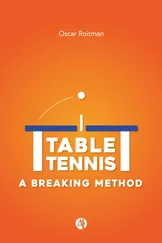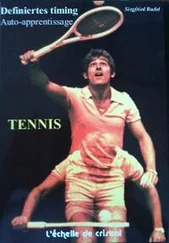Modern table tennis: strokes, trainings, strategies
Artyom Utochkin
Vasilii Zhdanov
Ivan Zhdanov
© Artyom Utochkin, 2018
© Vasilii Zhdanov, 2018
© Ivan Zhdanov, 2018
ISBN 978-5-4493-3190-8
Created with Ridero smart publishing system
Hello, dear reader! If you keep this book in your hands, then you are interested in table tennis, and especially you are interested in its modern state. In this book, we’ll talk about the development trends of this fascinating Olympic sport.
We promise that the journey to modern table tennis will be interesting for you, and most importantly, useful. We are sure that you will learn a lot from the pages of the book, in which we consider the basic strokes paradigm shift: the forehand topspin (loop), the backhand topspin and the serves. We will tell about different variations of strokes in detailed illustrations. You will become more aware of how to strike in a particular situation. Drawings are simple and understandable and you can easily repeat it at home. Let’s go deep into the psychological training of athletes in table tennis and touch on powerful and effective approaches that will be useful for a coach and an athlete.
We tried to put our coaching experience into this book, as well as our research and knowledge of table tennis. We encourage you to share the information you liked about this book with your friends-athletes, so you will further strengthen the new knowledge that will eventually evaluate into playing skills. Whether you are a recreational athlete, a professional or a table tennis coach, in this book everyone will find something for themselves.
Artyom Utochkin
Vasilii Zhdanov
Ivan Zhdanov
Chapter 1. Modern table tennis
Table tennis is constantly and actively developing. New approaches and methods are introduced into the training process; the style of the game today is very different from the style of ten or twenty years ago. Table tennis is becoming a gloving and high-speed sport: the main purpose of the rally is to seize the initiative. There are players with versatile styles as opposed to one-sided style directions. Masters begin to add ball’s maximum spin, as well as speed; and ball possession stability and the ball accuracy increases every year. Attaking actions are carried out both from the near and the middle zones, while the zones change occurs without loss of initiative. The strokes are becoming more sharp and unexpected, as well as with constant sidespin. The psychoemotional preparation and stability in the matches comes to the fore. It is about these new trends we are going to talk in our book.
The prehistory of the forehand topspin, or how we came to a modern version of the stroke. History of the paradigm shift
Before discussing the forehand topspin technique and features of its tactical use, let’s take a look at the history of table tennis and see how the forehand topspin was born and transformed before it obtained a modern look that you can see at major tournaments or browsing matches of any of the strongest athletes of the world on YouTube.
In the 20—30’s of the last century, the rackets that were used to play table tennis were differed from the modern ones, just as the computers of the 70’s differ from today’s personal laptops.
And if the shape of the racket has not undergone global changes, its playing characteristics have changed dramatically. At that time, pipped rubber was attached to the wooden blade, which provided more control and variability than the use of a simple bare blade without rubber.
Due to the pips, it was possible to chop the ball more gently and hit without spin. They nevertheless added some rotation to the ball and, therefore, it was much easier to strike, than striking with the blade without rubber.
The revolution occurred in the late 40’s, when the athletes began to use the “sandwich” rubber, that is, rubber sponge was glued under pips. Thus, the rubber began to consist of two layers, that is why it was called “sandwich” rubber.
We can say that this was already a prototype of the modern rubber sheet. Pips together with a sponge gave much more control, variability and ball spin. Table tennis made a step forward.
The next and most global step in the table tennis development was one of the world championships in the late 50’s, when the Japanese tennis players brought an absolute innovation – a “sandwich” rubber, consisting of a sponge and a smooth rubber surface. It was already an almost modern version of the rubber sheet (today, only the rubber characteristics are better – the essence remains the same). But the most important thing is what the Japanese athletes began to perform due to these rubber sheets.
We hope you have already guessed that they brought a heretofore unknown element to the world championship – that is the topspin (loop). By the way, Soviet athletes, visiting the world championship in 1961, called this element “the devil’s ball from Tokyo.”
Japanese athletes of that time used exclusively Asian racket grip, called “pen”. Such grip, in its classic performance, can be fully performed only at the forehand topspin, which was successfully applied by Japanese athletes at that and several of the next world championships; and they became undisputed favorites on these championships, winning 4 to 6 gold medals out of 7 sets of medals.
In the 1960’s, the forehand topspin technique was developing, largely due to the Japanese tennis players. The forehand topspin became a more high-speed element, and table tennis began to become more athletic due to the more physically trained players who performed the forehand topspin more powerfully and quickly.
In the 1970’s, Hungarian tennis players were among the leaders of the world table tennis. They began to use the possibility of overlap type “sandwich” to the maximum extent and modified technique of top-spin on the right.
They began to move a long distance from the table and, performed a loop drive (both forehand and backhand) with a very high trajectory up, lowering the ball almost to the floor.
At first, it seemed that the Hungarian athletes pushed the topspin development in table tennis a step back, because at that time there was a number of Japanese athletes who were approaching performing the topspin at the highest point of the ball’s rebound.
But, after reflecting on this, one can come to the conclusion that Hungarian athletes have shown a different topspin facet: the maximum spin. They were able to make maximum use of “sandwich” rubber with a smooth surface.
In the late 70’s and early 80’s, Chinese athletes took away the crown of table tennis, that before that was wandering between athletes from Sweden, Hungary and Japan.
How did they do that?
The Chinese found a weighty counter-argument against topspin with the maximum possible rotation. They began to play with the pips in the immediate vicinity of the table, focusing on the speed and game acuity, giving no time and opportunity for European athletes (many of whom tried to play in the Hungarian style) to perform serial top-spin from the middle and far zones, who added strong rotation to the ball.
It was the fight of styles that led to a new paradigm of performing the forehand topspin, which was designated by young Swedish tennis players. They changed the forehand topspin technique by making the movement shorter and more rational. Due to this technique, the ball reached almost the same rotation as at the topspin from the far zone, but the ball speed increased dramatically.
Читать дальше












